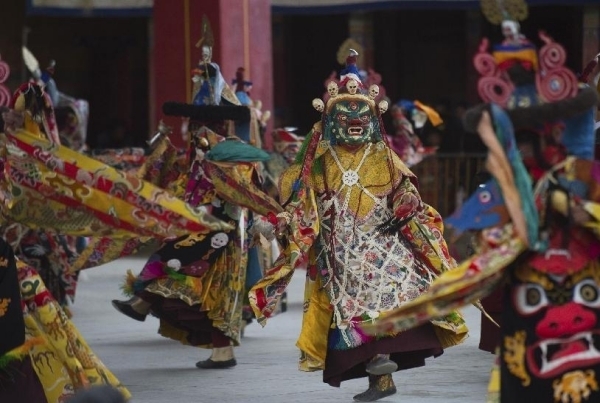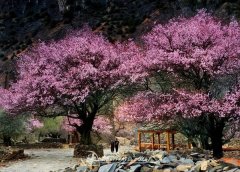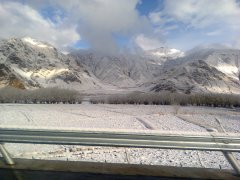
The source of Vajra dance(Cham dance) of Samye Monastery in Tibet

Cham dance, or Vajra dance short for Exoteric Vajra Gar Cham dance, is an all-round religious dance and a cultivation ritual of Vajrayana.
Cham dance, or Vajra dance short for Exoteric Vajra Gar Cham dance, is an all-round religious dance and a cultivation ritual of Vajrayana.
According to Buddhism records: Samantabhadra taught the Vajra dance to the Five Wisdom Buddhas (Vairochana, Ratnasambhava,Amitabha, Amoghasiddhi and Akshobhya) when he turned the Esoteric dharma chakra in the Dharma realm. The Five Wisdom Buddhas then taught the Vajra dance to the fanitees — Avalokitesvara Boddhisattva, Manjushri Boddhisattva and Vajrapani Boddhisattva, who also taught the dance in their respective lineages. Afterwards, the Vajra dance was spread to Udyana (today's Afghanistan), India, Nepal and Tibet by several great Buddhist masters such as Padmasambhava.
In the middle of the 8th century, Trisong Detsen, the 38th Tubo King of Tibet, invited Shantarakshita, a great Indian philosopher and abbot to help found the Samye Monasteri and establish the monastic order in Tibet. During the construction of the Samye Monastery, it is said to be often disturbed by demons and devils that would destroy the project at night. Then the Tubo King Trisong Detsen invited Padmasambhava from Udyana to the construction.
In 775 A.D, Tibetan Wood Rabbit year, Padmasambhava established the Vajrakila Mandala on Mt. Hepori (one of Tibet's four holy mountains) east to the Samye temple, and performed the Vajrakila dance with Bodhicitta, which helped him to observe the local geography to coordinate all the disharmonious elements and defeat all the demons and devils. Thus, the Samye Monastery was built.
At that time, Mashang Drompakye, a Bonist believer and high official, was buried alive and died with a sore anger. His soul transformed into a ghost that harms the human being. To return his soul back to the Sukhavati, Padmasambhava performed an episode of solemn Vajra dance(II), after which the ritual procedure was passed down from Padmasambhava to Trisong Detsen and his wife . After the ritual procedure was established at Samye Monastery, 51 Vajrakila Buddhas came to perform Vajrakila religious dance (I) and (II), marking the birth of Vajrakila dance at Samye Monastery.
As originated at Samye Monastery, Vajra dance boasts an immeasurable historical status. In 2014 the dance has been included in the state-level intangible cultural heritage list of China.
Vajrakila dance is known for beautiful melody and diversified steps that are either peaceful or solemn and make up the 'nine techniques' of dance.
Samye Monastery Vajra dance is performed at two occasions:
-on annual May 15 by Tibetan calendar and lasts for three days with 34 parts
-on January 10 of the Monkey Year by Tibetan calendar and lasts for two days with 28 parts
Each year at the first occasion, the ritual attracts over 10,000 tourists and Tibetans Buddhists from across the globe.

With exceptional passion and outstanding leadership, Mrs. Catherine has dedicated herself to Tibet inbound tourism and China tour for 15 years. As one of the handful females who see great potential of Chinese inbound tourism, Catherine has made great contribution to promoting Tibet tourism and enhancing the employment of Tibetans and prosperity of local Tibetan community.
Over the years, she travelled overseas with Tibet Tourism Bureau many times to promote Tibet tourism. Currently, Catherine works as the marketing director of Tibet Vista, an opinion leader behind the whole team of Tibet Vista.
Related Articles & Posts

Latest Tibet Travel News

Tibet Vista: A Social Responsible Tour Organizer
Aug 14,2023

Tibetan Monks Debate in Drepung Monastery
Jun 10,2023

Tips for Traveling to Tibet in Spring
Feb 17,2022

Snow Will Hit Qinghai-Tibet Plateau
Feb 17,2022


.jpg)




0 Comment ON "The source of Vajra dance(Cham dance) of Samye Monastery in Tibet"